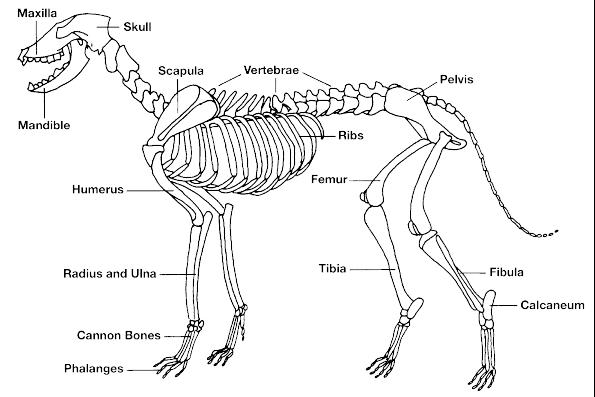 Introduction to Archaeology
and Palaeoanthropology:
Introduction to Archaeology
and Palaeoanthropology:
 Introduction to Archaeology
and Palaeoanthropology:
Introduction to Archaeology
and Palaeoanthropology:
Humanity's Journeys
Dr. Kathryn Denning
Anth 2140, Sept 2005 - Apr 2006
29 Nov 2005... Welcome!
Plan for the day
1 Course business/ announcements...
2 Back, briefly, to modern human diversity from last week
3 On to archaeology: from things to people
Schedule
For today: Having learned about human biology and evolution, we are returning to archaeology, i.e. more about human history and culture. Fagan chapter 4 and chapter 5.
Next week: Fagan Ch 6 and Ch 7
Quiz #3: in lecture on Dec 6th. We will have this at the start of class. Late-comers will not receive extra time. Review notes are here.
If you're interested in Body Worlds, at the Ontario Science Centre... there will be a lecture series this week (Weds, Thurs, Sat). Tickets: $10 for students. Topics include the ethics of displaying the dead.
http://www.ontariosciencecentre.ca/calendar/default.asp?eventid=413
FOR TUTORIAL TOMORROW... come prepared to discuss some questions about Ötzi the Ice Man (will be mentioned at the end of class today)
Recapping, including what we covered last week about 'race' and racism:
* Early theories -- popular among the general public and among scientists too -- emphasized deep differences between different "races" of people.... inequalities caused either by Creation or by Evolution
* Scientists have sometimes made substantial errors in 'measuring' the worth -- e.g. IQ, brain capacity, etc. -- of people, and this has had terrible consequences within society (e.g. forced sterilization, elimination of entire populations, treating people as subhuman research objects). Some scientists still believe there are "racial" differences in intelligence etc., and advocate different social programs for different "racial" groups. N.B. Some early anthropologists used to do research like this, believing that "deep differences" were real, e.g. between "races", between the sexes, and between good people and criminals, between the intelligent and the "feeble-minded". The majority of anthropologists and medical scientists don't do this anymore, because they believe it is both pointless and wrong.
* Our current best understanding of both (a) evolutionary biology (the species) and (b) human development (the individual) says that:
- differences within groups are bigger than differences between groups
- general differences between populations are very small and cannot be biologically described as discrete groups (that is, skin and hair colour do not vary in conjunction with intelligence etc.), so "race" isn't a biologically useful concept
- characteristics like appearance (height, skin colour, etc.) and mental abilities are very much influenced by nutrition, developmental influences, environmental influences, cultural opportunities, etc.... i.e., they are not simply genetic.
Remaining issues
Popular ideas about intelligence -- often-quoted facts or "facts" -- usually only look at one tiny part of a large and complex picture, and make unwarranted generalizations.
Are there differences in people's intelligence? Yes.
Can we simply define intelligence? No.
Can we test for intelligence in a way that eliminates cultural variables? No.
Is intelligence a singular quality? No.
Are differences in intelligence simply genetic? No.
Do differences in intelligence simply correlate to ethnicity or to "race"? No.
Can intelligence be affected by maternal health, child nutrition, and access to education? Yes. Profoundly. Are those factors distributed evenly across society / societies? No.
Question to keep in mind: What, exactly, is the point of studying differences in intelligence? Can this ever be a simple scientific question?
Recommended reading: The Mismeasure of Man, by Stephen J. Gould. (on reserve at Scott Library for this course)
Relevant section:
"The confusion of within- and between-group heredity.
The major political impact of hereditarian theories does not arise from the inferred heritability of tests, but from a logically invalid extension. Studies of the heritability of IQ, performed by such traditional methods as comparing scores of relatives, or contrasting scores of adopted children with both their biological and legal parents, are all of the "within-group" type -- that is, they permit an estimate of heritability within a single, coherent population (white Americans, for example). The common fallacy consists in assuming that if heredity explains a certain percentage of variation among individuals within a group, it must also explain a similar percentage of the difference in average IQ between groups -- whites and blacks, for example. But variation among individuals within a group and differences in mean values between groups are entirely separate phenomena. One item provides no license for speculation about the other."
- The Mismeasure of Man, by Stephen J. Gould, p 186
Consider: Why is all this important in a course about human history?
For this week, you read:
Fagan Chapter 4, 86-119, How Did People Live?
Topics there include....
Ancient Technologies
stone, bone, antler, wood, clay, metals, basketry, textiles
(n.b. invention of plastics is recent! mid-1800s onwards)
Subsistence: Making a Living
Animal bones (zooarchaeology, faunal analysis to determine... wild or domesticated, hunted or farmed, when hunted and how)
Plant remains (flotation, etc.)
Fishing and fowling (birds), shellfish (e.g. clams)
Reconstructing Ancient Diet by examining human remains and feces too
* from the skeleton - carbon isotope analysis (C12/C13 for marine/land; C3/C4 for different plant types, indicating farming) and other stable isotopes (e.g. strontium)
* feces provide a very direct indicator of what people ate
Classifying Artifact Types

Making Stone Tools
- two kinds - ground stone and chipped stone
- note the archaeological illustration conventions here of seeing all sides of the piece


Folsom Point
- making chipped stone tools is called 'knapping' (do not try this at home! or if you must, practice safe stone-working... wear protection)
- chipped stone tools can only be made from rocks that have a high silica content, often containing lots of tiny crystals. Flint, chert, basalt, quartz, obsidian (volcanic glass). They break like glass - conchoidal fracture... curved surfaces.
Below: Conchoidal Fracture in obsidian -- the 'point' is the place where the rock was initially struck -- the energy of the blow radiates outwards in a predictable way.
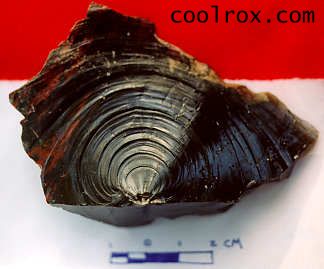
Three main methods of flint-knapping:
a) direct fracturing with a hammerstone
b) hammering with a soft hammer (bone)
c) pressure flaking with a punch
These methods each leave a specific fracture pattern -- thus archaeologists can tell how a tool was made!
Direct fracturing with a hammerstone

Making blades using a punch
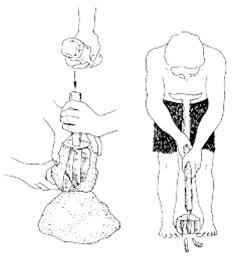
From Prepared Core to a Flake Tool
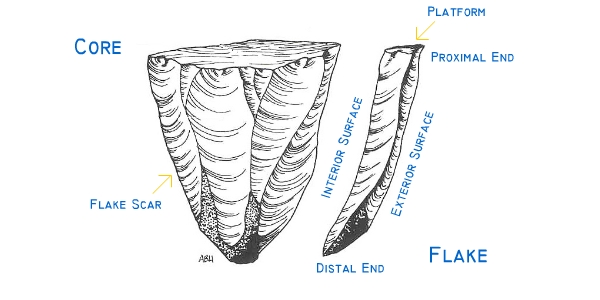
Illustration borrowed from: http://www.utexas.edu/courses/denbow/labs/lithic2.htm
Lithic Analysis
- i.e., what archaeologists do when they find stone tools or the waste flakes (debitage) left by the process of making stone tools
Aims of lithic analysis
- to understand the overall process of making and using stone tools (the chaîne opératoire or operational sequence) -- the stages of tool production from the acquisition of raw material to the making of the tool to the use of the tool to its abandonment... insight into human thought and behaviour
- to understand site formation and behaviour
Methods of lithic analysis include
- use-wear or edge-wear analysis
using a stone tool to cut things leaves distinctive marks on the tool - so archaeologists can figure out what it was used to cut, and how
e.g.s http://www.essex.ac.uk/psychology/rogerg/research/use%20wear/useWear.html
- petrological analysis
analysis of rock itself to locate the quarry (source) it came from... sometimes rock is traded very long distances!
- experimental archaeology
- core refitting
Core refitting
- best undertaken by the extremely patient
- reveals procedure used by knapper
- refitting flakes that are separated by a lot of space reveals activity patterns (e.g. start knapping in one place, then move to another, leaving the waste flakes behind)


Two pictures, same core. The 'slices' off the top are 'core tablets', to make a nice striking platform. The part on the left side is the flake made by striking downwards on that platform.
Below - a harder one... but they get much harder than that, too...

Images borrowed from: http://www.texasbeyondhistory.net/pavoreal/paleoindian.html
Other Ancient Technologies
made from...
bone, antler, wood, clay, metals, basketry, textiles
Attributes of Clay Vessels
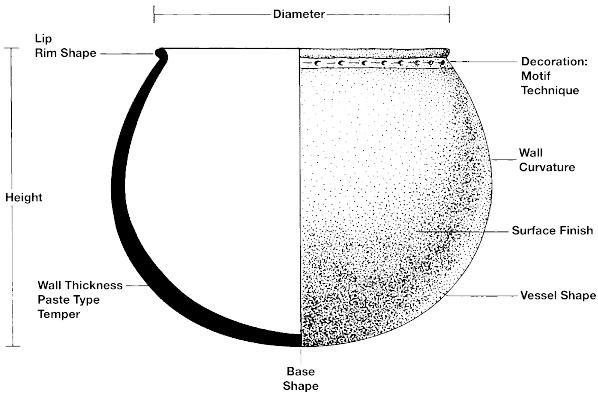
USES OF CLAY VESSELS IN THE PAST
ARCHAEOLOGICAL CONTEXTS OF CLAY VESSELS
WHAT WE CAN TELL FROM CLAY VESSELS: CONTENTS, AGE, SOURCE OF CLAY & TEMPER, AND SOMETIMES THE STYLE CAN TELL US ABOUT SOCIAL GROUPS
Subsistence: Making a Living
Plant remains (flotation, etc.)
Fishing and fowling (birds), shellfish (e.g. clams)
Reconstructing Ancient Diet by examining human remains and feces too
* from the skeleton - carbon isotope analysis (C12/C13 for marine/land; C3/C4 for different plant types, indicating farming) and other stable isotopes (e.g. strontium)
* feces provide a very direct indicator of what people ate
Chapter 5: 121-143: Individuals and Interactions
Make sure you read this before tutorial tomorrow! This is the kind of stuff that will be very important as the course proceeds.
We'll address the biological parts of studying burials in the new year... but first, it's important to take some time to consider the display and study of human remains.
Case study: Ötzi the "Ice Man"
Clips from film "Return of the Iceman", from the NOVA series "Ice Mummies", 1998.
For tutorial tomorrow, come ready to discuss:
- what kinds of information have archaeologists been able to retrieve from Ötzi's body and belongings?
- what do you think about this kind of study of a dead human being?